In this world diabetes has become one of the greatest deadly diseases. An estimated 347 million people were affected due to this. With numerous problems diabetes also produces epilepsy. It is a brain disorder in which cluster of brain nerve cells signal abnormally. This worst condition leads to identify the precise classifier for the diabetic epilepsy risk level classification. For the classifier reliable fuzzy rule model is used. In the two input rule model heterogeneous fuzzy system and homogeneous fuzzy system have been analysed. With the simplified single input rule model SIRM fuzzy system is proposed. Both the fuzzy system has been individually tested for all the cerebral blood flow (CBF) level through the FPGA which can act as a Reconfigurable computing. The CBF, EEG signal features and aggregation operators are taken as an input parameter. The fuzzy processor is tested for the 200 cases of known diabetic patients and validated for 100 cases. All these were first analysed in matlab, then coded and simulated in VHDL after that synthesized in FPGA. Quality value and performance index has been calculated individually to select the better fuzzy classifier. Simulation and synthesis has been performed in windows and Open source environment. For all the CBF value with minimized false level this system has been checked for the various device families like Spartan and Virtex. The area, power and timing analysis of a fuzzy classifier has been checked out. The FPGA results were compared with matlab results. This result indicates FPGA output closely follows the matlab results. The tuned SIRM with five rules is selected which has the highest performance among all the system with 98.58% and quality value of 36.56. The average performance obtained for the VLSI system is 98.28.
Keywords |
| Fuzzy processor, simulation, synthesis. |
INTRODUCTION |
| Fuzzy system provides the technique to deal with
uncertainty and granularity. Fuzziness describes the
ambiguity of an event and randomness describes the
uncertainty in the occurance of an event. It is a nonlinear
mapping of inputs to outputs. Fuzzy if then rules is a
scheme for capturing knowledge that involves
imprecision. The no of rules increases exponentially with
the dimension of the input space (no of system variable).
This rule explosion is called principle of dimensionality
and is a general problem for mathematical models [27].
This problem can be effectively handled by the single
input rule model (SIRM). Generally in fuzzy IF THEN
ELSE conditions were used. In complex problem no of
precedents are ANDed to deal the tough situations. But the
no of rules to be used is increased exponentially. Based on
no of trials rule model can be reduced to smaller. In this
fuzzy processor measured CBF and derived CBF are the
two input parameters. Based on the truth value fuzzy
variables may take the range of value from 0 to 1. Instead
of numeric input values fuzzy system always uses
membership function abbreviated as MF [5]. To deal with
the crisp input the fuzzy system must convert it into
fuzzified quantity. For this purpose fuzzification interface
is used[31]. For applying fuzzy rules a rule base block is
incorporated [7]. But to provide the results to the outside
world defuzzification unit performs the FUZZY to CRISP
conversion [2]. To make correct decision the decision
making block is added. This is shown in Figure1. |
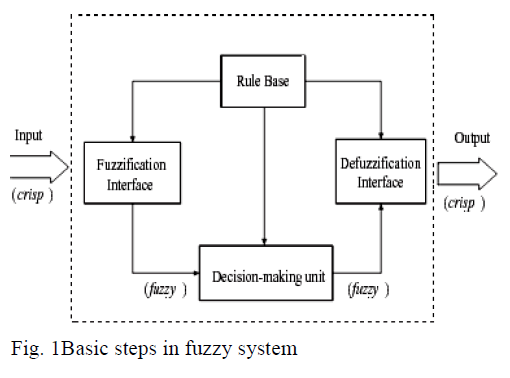 |
| After simulating the fuzzy processor code it is synthesized
through FPGA [29]. |
II. FUZZY PROCESSOR |
| Methodology of a fuzzy processor |
| The fuzzy processor inputs are cerebral blood flow (CBF),
Electroencephalogram (EEG) signal. This system consists
of various membership functions which includes bell
membership function also. To find the slope of the bell
MF aggregation operators were used. The results obtained
from one hundred clinically well defined test cases are
used for the system training. The purpose of the work is to
simulate and synthesis a fuzzy processor for a biomedical
application. Specifically in risk level classification of
diabetic patients. Since this risk level leads to epilepsy or
brain disorder[15]. Energy, peaks and spikes and sharp
waves and events are extracted from the EEG signal are
denoted as y1,y2,y3,y4,y5. The parameters such as index
of convulsions, seizure timings and total body fatigue are
the variable X. For the raw data EEG signal bipolar
channels of the count 16 were used. 200hz is fixed for the
sampling rate. The 17 test conditionas were clustered by
the R. Yager‟s ordered weighted aggregation (OWA)
method [1]. The measured CBF will have five linguistic
levels such as Very low, Low, Medium, High, Very high
[10]. |
| Fuzzy processor input membership function |
| Based on the CBF mechanism as CBF increases to
70%, the oxygen concentration on the blood stream
reduced by 30%. This epileptic convulsion risk is
increased in diabetic patients [3]. EEG can easily detect
the oxygen delivery and utilization in brain [4]. This
indicates correlation between CBF and EEG signals. |
| The linguistic fuzzy membership functions for the
heterogeneous system [26] are illustrated with the Figures.
Figure 2 shows the Input membership function (measured
CBF). Figure 3 shows the Input membership function
(derived CBF). Figure 4 shows the Output membership
function (epilepsy risk level). In all these membership
function X axis denotes CBF level and Y axis denotes the
membership grade. |
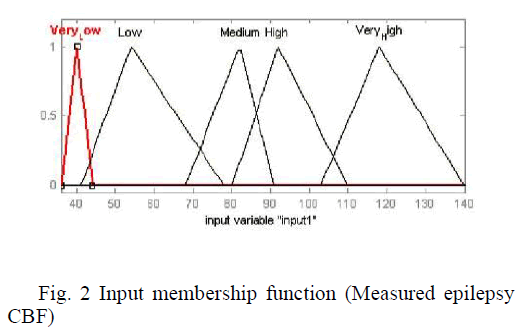 |
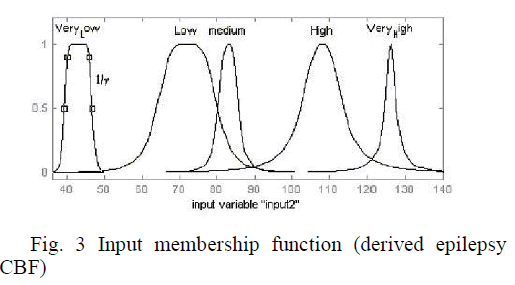 |
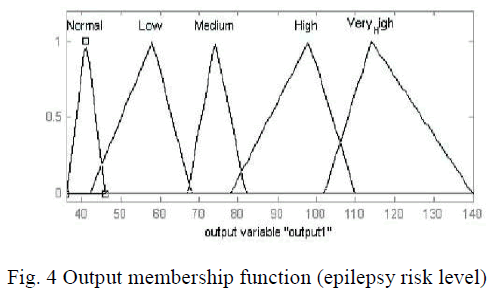 |
| Heterogeneous fuzzy rules |
| Mamdani type system with two inputs and one output
is the basic for this fuzzy processor [13]. After processing
the fuzzy Rules output must be converted into
corresponding numeric values. COG (Centre of gravity)
defuzzification is used here. The measured CBF input is
fuzzified with five linguistic variables like very low, low,
medium, high, very high using triangular membership
functions [18]. The other input is from EEG signal with
the bell shape membership function. Here aggregation
operators are used as conditioning tools. Those are used
for deriving slope of the bell shape MF. This fuzzy system
performs well with the following five Fuzzy Rules (Fr) in
the rule base such as [6] |
| Fr1: IF CBF is very low AND epilepsy CBF is very low,
THEN output epilepsy risk level is normal |
| Fr2: IF CBF is low AND epilepsy CBF is low, THEN
output epilepsy risk level is low risk |
| Fr3: IF CBF is medium AND epilepsy CBF is medium,
THEN output epilepsy risk level is medium risk |
| Fr4: IF CBF is high AND epilepsy CBF is high, THEN
output epilepsy risk level is high risk |
| Fr5: IF CBF is very high AND epilepsy CBF is very high,
THEN output epilepsy risk level is very high risk |
III. SIRM FUZZY PROCESSOR |
| A. Single Input Rule Model |
| The conventional fuzzy inference model which
puts all the input items into the antecedent part of fuzzy
rule, causes the total number of possible fuzzy rules to
increase exponentially with the number of the input items
and has difficulty in setting up each rule [12]. The SIRM‟s
dynamically connected fuzzy inference model is applied,
to over come these problems. The SIRM fuzzy processor
is given in Fig. 5. |
 |
| The applied SIRM fuzzy system is designed with five
rules in the rule base and measured CBF as the only input. |
| SFR 1) IF CBF is very low THEN output epilepsy risk
is normal |
| SFR 2) IF CBF is low THEN output epilepsy risk is low
risk |
| SFR 3) IF CBF is medium THEN output epilepsy risk is
medium risk |
| SFR 4) IF CBF is high THEN output epilepsy risk is
high risk |
| SFR 5) IF CBF is very high THEN output epilepsy risk is
very high risk |
| The membership function of measured CBF is bell
shaped and slopes function (1/γ) is embedded with EEG
signal information . The output epilepsy risk level of this
system uses triangular membership function. The input
membership function of the SIRM fuzzy system is shown
in Fig. 6. |
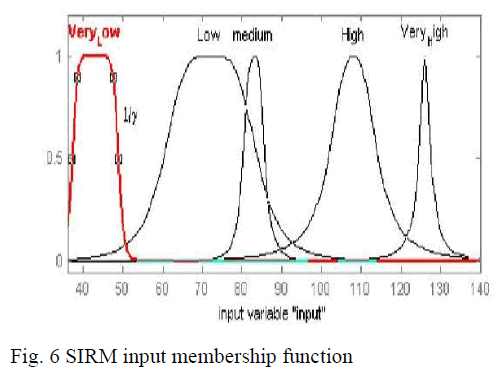 |
| B. Literature survey |
| This VLSI fuzzy processor has been involved in
various application like medical diagnosis, High Energy
Physics Environment (HEPE), Biomedical application. |
| A review on VLSI based fuzzy processor is explained
in the paper. Here all the fuzzy processor which uses VLSI
for its coding and implementation were discussed in detail
[25]. In those discussion application may different. But all
those uses both fuzzy and VHDL tool. |
| VLSI fuzzy processor which is capable of dealing with
complex fuzzy inference systems is proposed in this paper
[8]. Inference includes the rule chaining process also.
Processor is made up of a no of pipelined stages. Its
performance is in the order of 2 MFLIPS with 256 rules,
eight inputs, two chained variables, and four outputs and
5.2 MFLIPS with 32 rules, three inputs, and one output
with a clock frequency of 66 MHZ. Hardware description
languages with a predefined function library is utilized in
VHDL modeling of fuzzy system. A generic fieldprogrammable
logic device (FPLD) based fuzzy logic
system aimed at high-speed applications is focused in this
paper [5]. It can be easily customized practically for any
application [21]. |
| This fuzzy processor is initially implemented in mat
lab and performance analysis like quality value and
performance index has been done. A diabetic neuropathy
–A case study is discussed in this paper [11]. They
simulated the numeric values and checked with the
previous results [20]. Fuzzy processor condition is
simulated with reduced false level [12]. Author pioneered
fuzzy processor diagnosis purpose to find BMI, Glucose,
Urea, Creatinine, Systolic and diastolic blood pressure
[19]. The generalized trapezoidal membership function
used here for the neural network tool analysis [24]. |
| To deal with the great amount of information fuzzy
processor exploits the parallism inherent in fuzzy
inference which is described in paper [22]. Floating point
arithmetic approach fuzzy processor is explained by this
author which follows the basic steps in fuzzy system [23].
A review on all the fuzzy processor based on VLSI is
described in the paper [25]. |
| This work emphasis on heterogeneous and
homogeneous fuzzy processor. The simulation and
synthesis condition in windows and FOSS environment. For
a convenience only the heterogeneous system is discussed. This work also describe about design statistics, device
utilization summary, power |
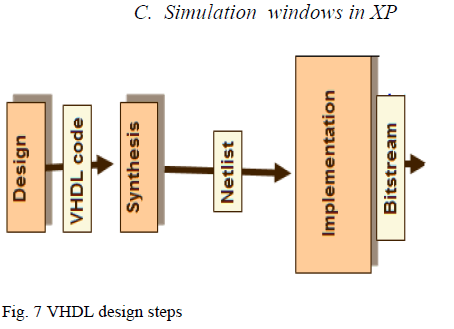 |
| FPGA‟s are the perfect rapid prototyping of digital
circuits. These are used to implement the required logic in
a chip. Basic steps in VHDL design steps are coding,
synthesis, netlist generation and implementation [32].
Those process are shown in figure 7. Here logic synthesis
used to convert VHDL description into netlist. Once the
design is implemented a file must be created that FPGA
can understand. That is termed as bitstream. The bit file
can be downloaded directly to the FPGA. Fuzzy system is
simulated in VHDL and synthesized for various CBF
levels. |
| Here the membership function is checked for continuous
range of CBF levels. For an example in bell MF if the
input CBF is 81 then the fuzzy systems has to identify
under which linguistic the CBF falls. If the input CBF falls
under more than one linguistic it will be calculating all the
function values based upon the aggregation operator and
output is produced. Here maximum operator is used for
the final function value fixation. In Figure 8 lower CBF
value has been applied. |
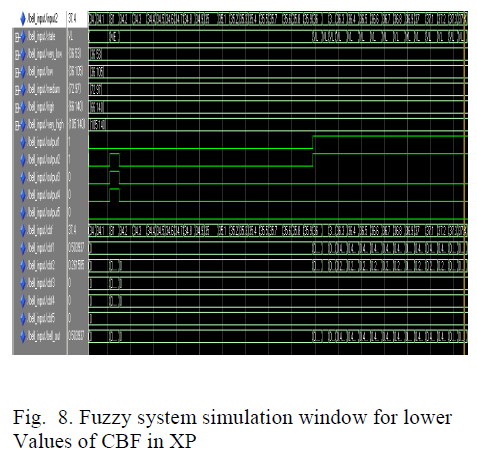 |
| The fuzzy system performance has been evaluated for all
the linguistic levels with maximum values. For a set of random CBF value simulation window has been displayed
in Fig. 9. |
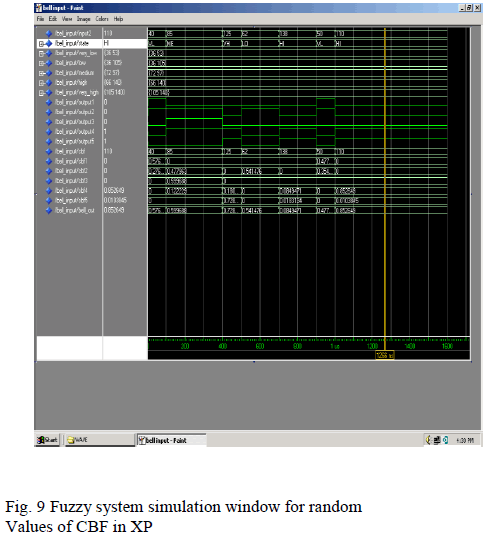 |
| Figure 10 shows the internal diagram of FPGA. It consists
of number of CLB „s which can be easily programmed. |
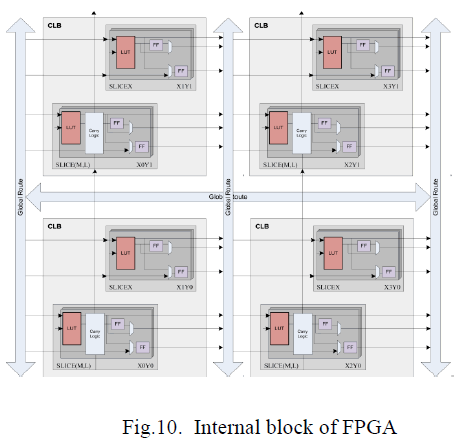 |
| Each CLB contains two sets of the 4 input LUT, any 4 I/P
logic function or (16bitx1) synchronous RAM
(SLICEM)only carry and control, Fast arithmetic logic
Multiplier and multiplexer logic, Storage element, Latch
or Flip Flop, Set or reset, True or inverted input. Each
LUT can implement any function of 4 input. |
| Once the fuzzy system VHDL code gets simulated, it is
synthesized through Xilinx ise 9.1i tool. If this process is
successful Spartan device gives the impact window as a
result. It is given in Fig 11. |
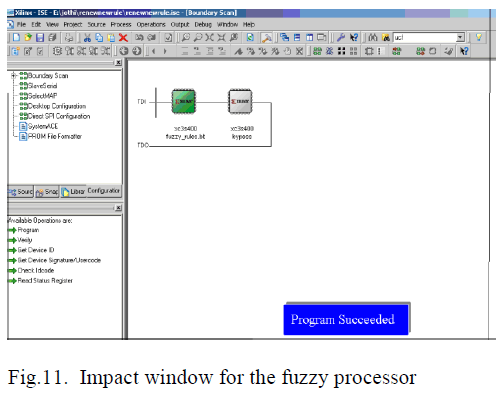 |
| D. Simulation and Synthesis windows in FOSS |
| This same VHDL code was simulated and synthesized
through xilinx ise 9.1i in FOSS (Free and Open Source
Software) is shown in Fig. 12. It is liberally licensed
software to grant the the source code access. Its
installation also becomes easier with virus free condition.
All the fuzzy system homogeneous and heterogeneous
were first simulated. |
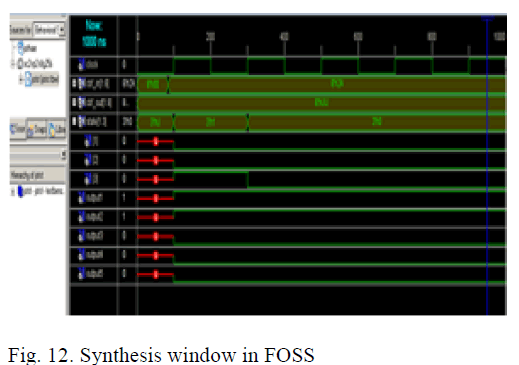 |
| After synthesizing we can obtain two types of schematics.
Those are RTL and technology schematics. The
technology schematic (Tech schematic) gives in depth
information about the function implemented through that
logic. Net list generated by the Xilinx Synthesis Tool is
available in technology view. It also gives karnaugh map
with the related truth table. Configurable logic blocks
(CLB) constitute the main resource for implementing
synchronous as well as combinational circuits [16]. Each
CLB contains four slices and each slice contains two
LUTs to implement the logic [28]. That is given in Fig.
13. |
| The graphic representation of the design is denoted
by RTL schematic (Register transfer level). Derivation of
main logic construction is given in RTL view. It is a
schematic representation of the pre optimized design in
terms of generic symbols like adder, multiplier, counter
independent of Xilinx device. Where schematic denotes a hierarchical design representing a design in terms of user
and library components. |
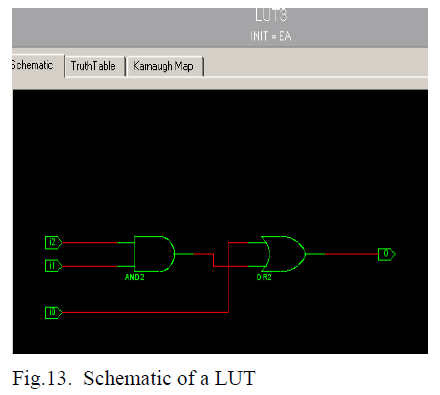 |
| The karnaugh map for the one of the logic in fuzzy system
is shown in Fig. 14. |
| The INIT attribute with an appropriate number of inputs
must be attached to LUT to specify its function. Instead
of normal input, the hexadecimal equivalent is used here. |
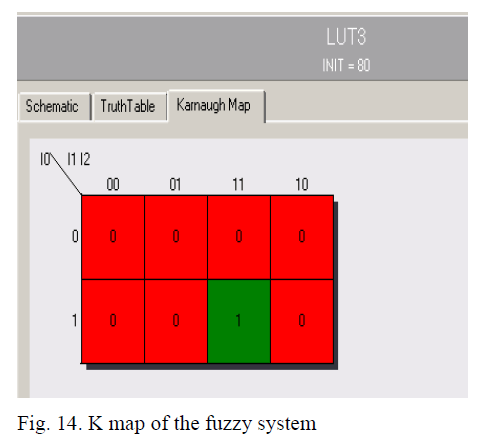 |
| During this step, XST tries to recognize as many basic
macros as possible to create a technology specific
implementation. |
IV. RESULTS AND DISCUSSION |
| A. HDL Synthesis macro statistics : |
| During this step, XST performs advanced macro
recognition and inference like recognizing dynamic shift
registers, implementing pipelined multipliers, coding
state machines etc. HDL synthesis macro statistics is
given in TABLE. 1 |
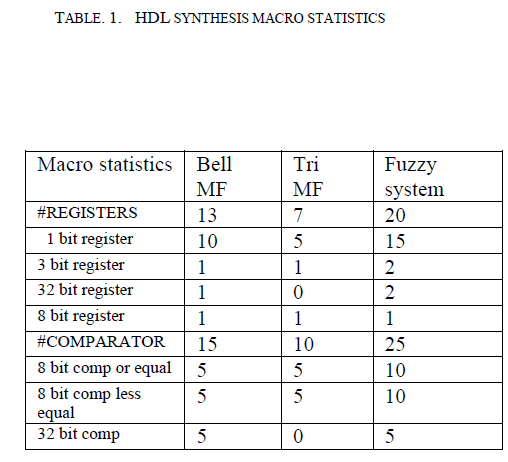 |
| Advanced HDL synthesis macro statistics is given in
table 2. |
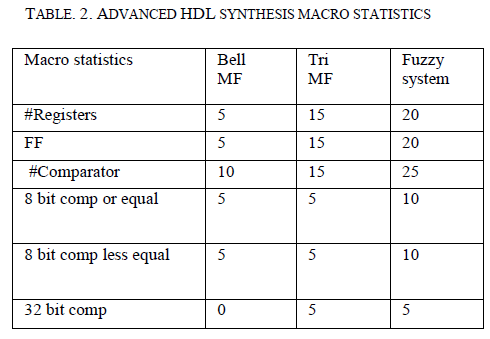 |
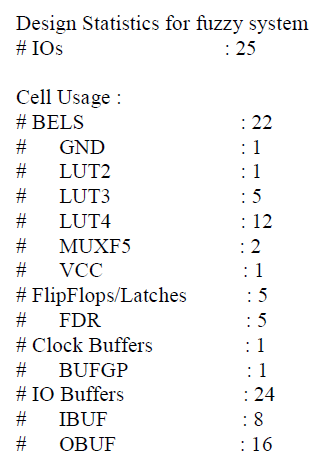 |
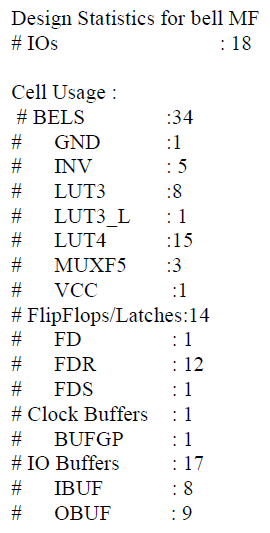 |
| BEL denotes Basic Elements that make up a CLB,
IOB, Block RAM, FF. Here LUT2 denotes 2 bit LUT with
general output. LUT3 specifies 3 bit LUT with general
output. LUT3_L notifies the 3 bit LUT with local output.
MUXF5 mentions the primitive 2 to1 LUT multiplexer
with general output. Where FD denotes D FF [14], FDR
for D FF with Reset. Buf GP is Global clock buffer. Table
III shows the power report for the implementation of fuzzy
system. Total power is 80.98mw. Here Vccint is the main
power supply for the FPGA‟S internal logic. To optimize
the FPGA function Vccaux is used. |
| B. Quality value |
| The quality value Qv is defined as [10] |
 |
| Where C is the scaling constant. |
| Rfa is the number of false alarm per set |
| Tdly is the average delay of the onset
classification in seconds |
| Pdct is the percentage of perfect classification |
| Pmsd is the percentage of perfect risk level missed
0.2- constant |
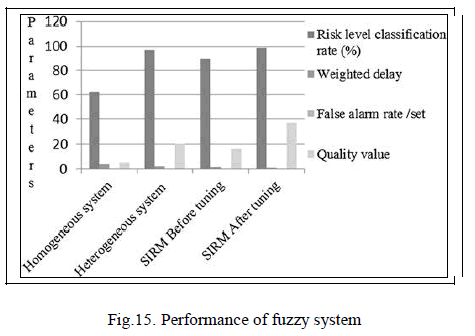 |
| It is observed from the Fig. 15 that the two input fuzzy
techniques are inherited with maximum weighted delay
and they are slow in their classification response. The
tuned SIRM fuzzy system is the best one based on the
lowest delay, higher performance and higher the quality
value of all the four fuzzy systems used for epilepsy risk
level classifications. |
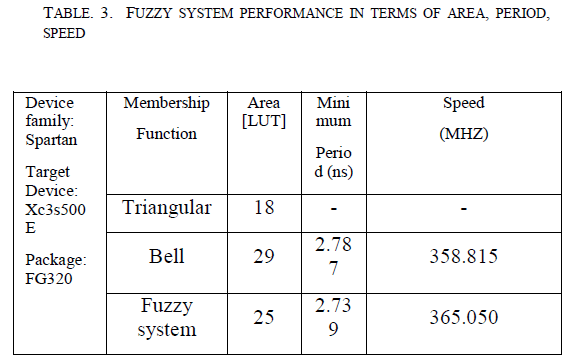 |
| In TABLE. 3. Area utilized by the fuzzy system is
mentioned in terms of LUT‟s. And the speed is given in
MHZ [30]. |
| Schematic, K Map, Truth table has been obtained for
the homogeneous system, heterogeneous system which
includes triangular MF, bell MF. It shows that only few
parts of the resources were used to implement the logic.
Device utilization has been analyzed not only for fuzzy
system but also for triangular membership function and
bell membership function. Since in SIRM only one MF
will be used. Here slices contains LUT‟s and storage
element [20,28]. |
| Fig. 16 shows the diagrammatic representation of the
device utilization. Where TRI denotes the Triangular
membership function and FUZ SYS represents the fuzzy
system. BELL denotes bell membership function. |
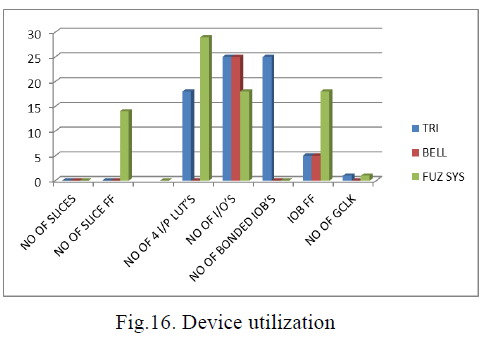 |
V CONCLUSION |
| The heterogeneous and homogeneous fuzzy system is
simulated and synthesized for the input CBF values using
Spartan3E device XC3S500E target device FG320
package in Xilinx ise 9.1i UBUNTU 10.1 open source
environment. This performance results closely follows the
previous MATLAB results. Using synthesis process RTL
view and technology view has been analyzed with the
power reports and Device utilization summary. FPGA
synthesis closely follows the previous results. The
methodology proposed and FPGA results will aid in ASIC
design of the fuzzy processor. Based on the area, power,
speed reports a fine tuning can be given to the fuzzy
processor design to obtain minimum power, smaller area
and higher speed. Further focus on this work is to design
optimized fuzzy processor using GA, NN tool. |
References |
- Ronald R.Yager ,‟On Ordered Weighted AveragingAggregation operators in multi criteria decision making.‟IEEE Transactions on Systems Man Cybernetics, vol 18,no1. 1998,pp183-190.
- Buhler,H.reglagepar la logiquefloue,lausanne,pressespolytechniquesatuniversitariesRomandes,”Fuzzy processingimplementation in dedicated digital hardware”.1994
- J. N. S.Mathews,”Statistical Method for the estimation ofCBF using kety-schmidt technique”, clinical science, vol 97,1991, pp 485-492.
- Muro,”A Mathematical model of cerebral blood flowchemical regulation-Part II”, IEEE transaction on Bio-medicalengineering, vol 36, no2, 1989,pp 192-201.
- Zoransalcic, “High speed customizable fuzzy logicprocessor:Architecture and implementatiom,”IEEEtransaction on system,man,andcybernetics-parta:system andhumans,vol 31,no 6, nov 2001.
- Dr.R.Sukanesh, Dr.R.Harikumar,”Performance analysis ofdifferent fuzzy techniques in classification of epilepsy risklevels for diabetic patients”, Vol 88,IE (I) journal, May 2007.
- M. Young, The Technical Writer's Handbook. Mill Valley,CA: University Science, 1989.
- Giuseppe ascia,vincenzocatania,marcorusso,etall,”Ruledriven VLSI fuzzy processor,”IEEE micro, 1996.
- R. Harikumar and S.Selvan,”Analysis of CBF in diabeticneuropathy using impedance technique”,proceedings ofNCBME‟97,Anna university, Chennai,march 1997, pp3.11-3.14.
- Yuhuishi,”Implementation of evolutionary fuzzysystem”,IEEE transaction on fuzzy system, vol 7,no 2,1999,pp 109-119.
- K.Paramasivam, Dr.R.harikumar, R.Sundararaja,”Simulationof VLSI design using parallel architecture for epilepsy Risklevel diagnosis in diabetic neuropathy”,IETE journal ofresearch,vol 50, No 4, 2004.
- R.Harikumar, M.Ishwaryadevi, M.Jothi,”FPGA synthesis ofheterogeneous and SIRM fuzzy system for the classificationof diabetic epilepsy risk levels with reduced false levels”,International conference on sytemics,cybernetics,andinformatics,Pentagram Research Centre,PP.91-96 Hyderabad2011
- R.Harikumar,Dr.R.Sukanesh, B.Sabarishnarayanan,“Application of aggregation operators in fuzzy logic basedclassification “,Proc. Of annual convention andexhibition(ACE)IEEE India council 2003,Pune
- Spartan 3E reference manual, 2012.
- Clement C.Pang ,”A comparison of algorithms for detectionof spikes in the EEG”,IEEE transaction on biomedical engg,Vol 50,no4,pp521-526, 2003.
- Xilinx reference manual,2009.
- P.Leo and MdKarall, “Joslin diabetes Manual”, chapter 16,Lea and Febiger, philadelphia,london, 1989.
- P.McCauley-Bell and B Adedoji, “Fuzzy modelling andanalytical Hierarchy processing to quantify risk levelsassociated with occupational injuries-PartII”, IEEEtransaction on fuzzy systems, Vol 4,no 4,1996,p 124.
- Shubajit Roy Chowdhury, hiranmaysaha, “Development of aFPGA based fuzzy neural network system for early diagnosisof critical health condition of a patient”, Computers inbiology and medicine,Elsevier,2010, 190-200.
- Dr.N.B.Balamurugan, M.Jothi ,R. Harikumar,”FPGAsynthesis of SIRM fuzzy system for diabetic epilepsy risklevels from EEG and ECG signal parameters”,Lecturer notesin Electrical Engineering, Volume 221,Springer,2012.
- T.Hollstein, S.K.halgamuge, and M.gloesner, “Computr –aided design of fuzzy system based on generic VHDLspecifications, “IEEE Trans.fuzzysytem, Vol.4, pp403-417,nov 1996.
- M.Ibrahim,”Fuzzy logic for embedded systems applications”,Elsevier science, USA, 2004
- PrzmyslawM.Szecowka,adammusial, “On hardwareimplementation of fuzzy processing”, MIXDES 2010, 17thinternational conference on mixed design of IC& system,June 24-26,2010, Poland.
- Website:News and thoughts on everythingapple,<http://everythingapple.blogspot.com/2004/07/contrary-to popular-myth-g5-isnot-hot.html>.
- Jothi.M, Dr.N.B.Balamurugan, Dr.R. Harikumar, ”Fuzzyprocessor based on VLSI-A Review”,IEEE digital library,2013
- Giuseppe ascia,Vincenzocatania,marcorusso, “VLSIhardware architecture for complex fuzzy systems”,IEEEmicro,1999.
- David falcheri, Alissandrogarbriellai, EnzoGandolfi, ”Veryfast rate fuzzy processor for high energy physics with 2 inputsand 1 output”,Fuzzy sets and sytems 132(2002),261-272.
- Murtada M. Abdulwahab, Abdul Rasoul J. Alzubaidi, “Encryption design based on FPGA usingVHDL”,International journal of Computer Science andNetwork Security, vol 12, no 12, December 2012.
- Nasrisulaiman, ZeyadAssiobaid, M.H.Marhaban,M.N.Hamidon”FPGA based fuzzy logic-Design andapplication-AReview”,IACSIT,International journal ofEngineering and technology, Vol 1,No 5, December 2009.
- Timing analyzer guide 2.1i,”Xilinx development system.
- Marcel jacomet Roger walti, “ A VLSI fuzzy processor withparallel rule execution”, Tech engg school Biel-BienneMicrolab-13s.
- The Design warriors guide to FPGA‟s Devices,tools,flows,ISBN 07506760243, mentor graphics.
|